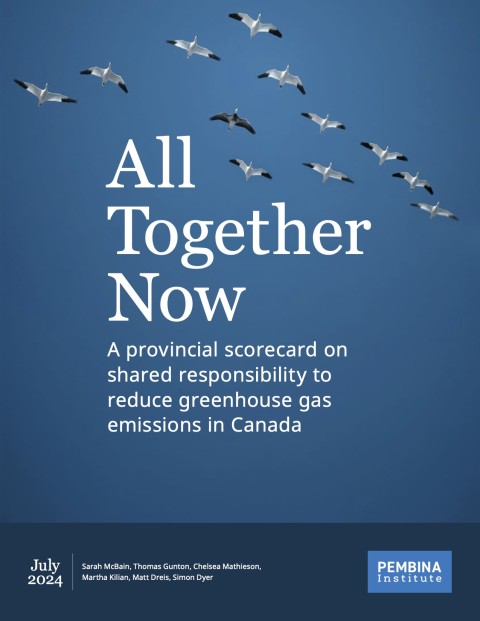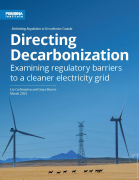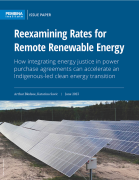This year, the Pembina Institute has again partnered with Simon Fraser University to compile a comprehensive assessment of the state of climate action by governments across Canada.
Canada has a key role to play in the international effort to limit global warming and mitigate the worst impacts of climate change. If we are to fulfill this role, all levels of government across the federation must act, together, with effective climate and energy policies.
Our report, All Together Now, rates the existence and efficacy of the climate plans and measures that are being pursued by Canada’s federal and provincial governments. It also includes a detailed analysis of each jurisdiction’s current efforts.
Read more below, or watch our joint webinar with Clean Energy Canada about what our organizations' research on provincial climate policy means about Canada's readiness to embrace the clean economy.
We must stay the course
The good news is that Canada’s climate policies are beginning to work. Emissions are starting to meaningfully fall in some locations and economic sectors. The latest data shows that in 2022, the first true post-pandemic year, overall emissions were lower than 2019, the last pre-pandemic year. As our levels of economic activity have ticked back up after covid, policies and regulations in Canada have ensured that our emissions have not.
Latest projections also indicate that, if all governments stay the course on the plans and policies that they have already implemented (or announced plans to implement), Canada would be on track to significantly reduce emissions by the end of this decade.
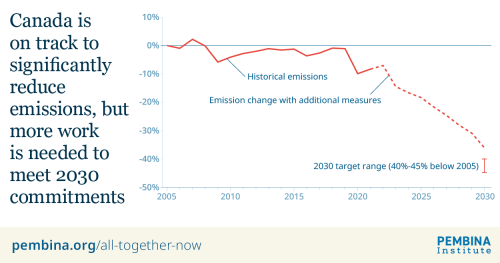
However, as this modelling shows, there is more to be done if we are to meet our international commitments to reduce emissions by 40%-45% by 2030 and net-zero by 2050. That is why a fundamental metric that we rated governments on was the existence of near and longer-term emissions reduction targets, as well as accountability mechanisms to achieve those targets.

Time to embrace a clean, safe, prosperous future
But climate policy-making is not only about reducing emissions. It is also about taking proactive steps to prepare all parts of our economy for the global shift to low-carbon energy that is already underway.
That is why we also assessed governments on specific policy tools being used to prepare key sectors for a low-carbon future. For example, we looked at governments’ use of measures such as zero-emissions vehicle sales mandates, plans to scale up clean electricity capacity, or changes to buildings codes to ensure zero-carbon homes are the standard.
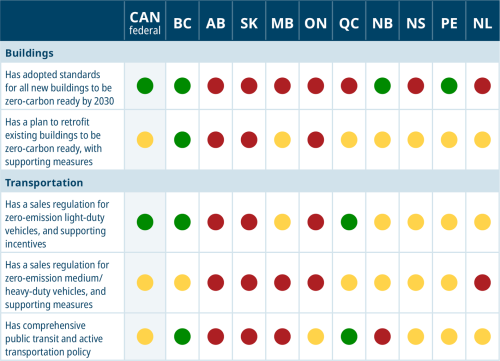
We also assessed the extent to which jurisdictions are incorporating reconciliation and equity considerations into their climate policy frameworks. For example, governments that have legislated UNDRIP (the United National Declaration on the Rights of Indigenous Peoples) received better ratings than those that have not. Those that have plans to reskill and support workers whose industries will undergo changes as part of the energy transition also performed more favourably in our ratings.
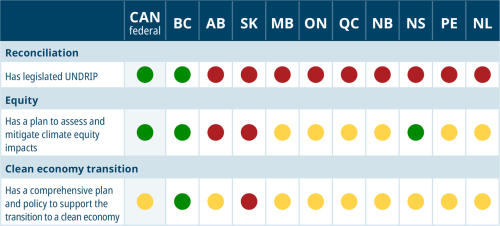
In including these aspects as part of energy transition planning, governments will have a better chance of ensuring a future that is not only climate-safe, but which provides fair and equitable opportunities and outcomes for all communities, workers and Indigenous peoples.
The leaders (and the laggards)
Our ratings scorecard shows the varying levels of action by different governments to reduce emissions and take advantage of the emerging new energy economy.
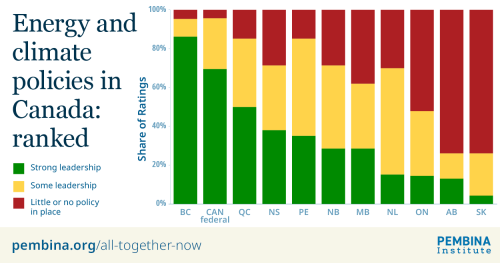
Three in particular are outperforming the rest: British Columbia, the federal government, and Quebec. All have shown strong areas of climate leadership, and received green scores for more than 50% of the indicators they were rated on (in BC’s case, 86% of its indicators were green).
However, nearly half of all Canada’s emissions come from and are the responsibility of two provinces: Alberta and Saskatchewan. Both provinces are the aggregate worst performers on our climate policy indicators, with Alberta receiving 13% green and 74% red ratings, and Saskatchewan receiving 4% green and 74% red ratings. These provinces are not only lagging in development of appropriate policies to reduce emissions in their own jurisdictions, they are also actively opposing some proposed federal policies, especially those that impact the oil and gas sector — still Canada’s biggest single source of emissions.
Citizens and communities across Canada expect their leaders to think ahead about how their needs will be met through the clean economies of the future. It is time to act, all together now, on climate.

External authors

Thomas Gunton
Thomas Gunton is a Professor at the School of Resource and Environmental Management of Simon Fraser University.

Chelsea Mathieson
Chelsea Mathieson is a master's candidate and research intern at the School of Resource and Environmental Management of Simon Fraser University.


